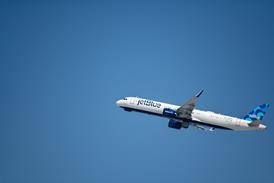Honeywell is working in concert with Gulfstream and Jeppesen to gain US Federal Aviation Administration approval for business aviation's first required navigation performance (RNP) instrument approach approval next year, a development the company says will boost airport access, fuel savings and environmental acceptance.
The avionics maker last week demonstrated the capabilities in its Gulfstream G450 using a modified Gulfstream PlaneView integrated avionics system and a prototype RNP approach developed by Jeppesen for Runway 5 at Morristown Municipal airport in New Jersey, a business aviation hub near New York City. PlaneView is based on Honeywell's Primus Epic avionics architecture.
RNP is a navigation method that takes advantage of a blend of GPS and inertial navigation information along with the software capabilities already on board most modern business jets, in order to qualify for varying levels of navigation services. The Morristown approach requires a navigation system capable of RNP 0.3, a typical value for the new breed of RNP approaches being developed by the US Federal Aviation Administration and two third-party providers, Jeppesen and Naverus.
RNP 0.3 means the pilot must have the appropriate information to observe and control the aircraft's actual position within a box of airspace that is 0.6nm (0.9km) wide (twice the RNP value) centred on the course set in the flight management system.
Pilots must monitor RNP information on the primary flight display, breaking off an approach if errors exceed the pre-determined RNP value for the approach. In Morristown last week, errors were generally less than 0.03nm, well below the 0.3nm threshold that would have necessitated a missed approach. Warnings to the pilots include the course deviation indicator in the PFD changing to an amber colour and an "RNP unable" warning displayed on the FMS screen on the centre console.
Chad Cundiff, vice-president of crew interface products for Honeywell, says benefits for business jet operators will include better access to terrain-challenged airports, fewer delays and diversions, and a reduction in noise and emissions, in part due to more direct routes to the airport, advantages some airlines are already achieving with the technology. Cundiff says Honeywell is planning to gain the experience in obtaining RNP approval for its Morristown-based flight operations department first before marketing its new services to other operators.
Along with modifying PlaneView for RNP, Honeywell is also planning to upgrade Primus Epic and other avionics for RNP operations. Cundiff says the company has also applied to the Federal Aviation Administration to become an RNP consultant, a service to help operators navigate the complex process of obtaining and keeping RNP approval, which includes validating the procedures in the aircraft and certifying that data updates every 28 days are correct.
Honeywell's effort hinges on Gulfstream gaining approval for RNP on its G450 and G550 models for RNP 0.3 Special Aircraft and Aircrew Authorisation Required instrument approaches, an effort Gulfstream plans to complete next year for an undisclosed customer.
Source: Flight International























